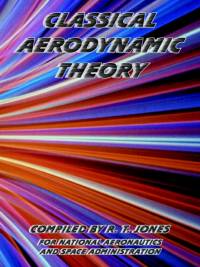Om Classical Aerodynamic Theory
Aerodynamic theory was not prepared to offer assistance in the early development of the airplane. The scientific community, most qualified for action at the forefront of human endeavor, often turns out in practice to be surprisingly conservative. It is recorded that Lord Rayleigh expressed "not the smallest molecule of faith in aerial navigation, except by balloon." It was not until experiments such as those of Lilienthal and Langley and the successful powered flights of the Wright brothers that correct theories for the aerodynamic action of wings were developed.
Following the successful demonstrations of the Wright brothers, aerodynamic theory developed rapidly, primarily in European laboratories. These developments we associate with the names Joukowsky, Kutta, Prandtl and his students, Munk, Betz, and Von Karman. It should not be forgotten that the writings of F. W. Lanchester provide many of the physical insights that were elaborated in these mathematical theories.
Throughout World War I, these developments in aerodynamic theory remained virtually unknown in the U.S. However, in the early 1920's, the U.S. National Advisory Committee for Aeronautics undertook to translate or otherwise make available important works on aerodynamic theory in the form of NACA Technical Reports, Notes, and Memoranda, and to encourage similar effort in its own laboratory.
At the present time, many of these old NACA documents are no longer readily available and it seems worthwhile to collect the most important early works under the title "Classical Aerodynamics." In most cases, the theories are explained in the author's own words and often with a degree of clarity unequalled in later interpretations.
R. T. Jones
Senior Staff Scientist
NASA-Ames Research Center
June 18, 1979
CONTENTS
Preface
Applications of Modern Hydrodynamics to Aeronautics
L. Prandtl
The Mechanism of Fluid Resistance
Th. v. Karman and H. Rubach
Pressure Distribution on Joukowski Wings
Otto Blumenthal
Graphic Construction of Joukowski Wings
E. Trefftz
The Minimum Induced Drag of Aerofoils
Max M. Mun K
The Aerodynamic Forces on Airship Hulls
Max M. Munk
Elements of the Wing Section Theory and of the Wing Theory
Max M. Munk
Remarks on the Pressure Distribution over the Surface of an Ellipsoid, Moving Translationally Through a Perfect Fluid
Max M. Munk
The Inertia Coefficients of an Airship in a Frictionless Fluid
H. Bateman
Flow and Drag Formulas for Simple Quadrics
A. F. Zahm
Flow and Force Equations for a Body Revolving In a Fluid
A. F. Zahm
Behavior of Vortex Systems
A. Betz
General Potential Theory of Arbitrary Wing Sections
T. Theodorsen and I. E. Garrick
General Theory of Aerodynamic Instability and the Mechanism of Flutter
Theodore Theodorsen
Visa mer

